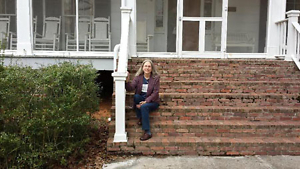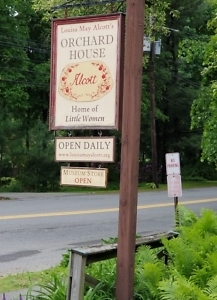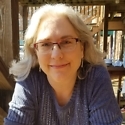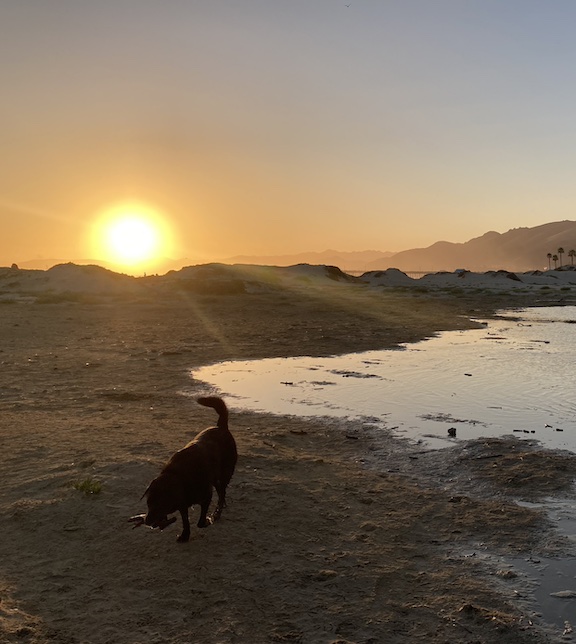There’s No Place Like Home
On the particular joy of visiting a beloved author’s house
I am drawn to the homes of famous writers like a wayfaring pilgrim on a lifelong literary crusade. Whenever an opportunity to travel presents itself, I research all the nearby possibilities (using a very generous definition of “nearby”) and painstakingly narrow them down to the most agreeable targets using a complicated algorithm that Mark Zuckerberg would admire. Then, somehow, I manage to talk my patient husband into going along for the ride. But he doesn’t really mind. He has seen what these nerdy excursions mean to me.

A visit to Stratford-upon-Avon is out of my reach for now, but thanks to the Folger Shakespeare Library’s First Folio tour in 2016, I was able to see with my own eyes not one, but two, First Folios. At the Parthenon in Nashville, I immediately burst into tears and spent almost an hour at the exhibit of this rare 17th-century book, just soaking it in. (See patient husband, above.) Some months later at Emory University in Atlanta, I brought my daughter to see my second First Folio – a document without which many of Shakespeare’s most beloved plays would likely have been lost – and proceeded to explain to the bemused student on duty in the display hall just how lucky he was to spend all day in the company of such a treasure.
But a book is not a home. A home is the locus of a life — the geographical center point from which the author’s words emanated. It is as close as we can get to the exact GPS coordinates where the muses showed up and sang. Especially for writers who are particularly identified with a specific place and time, home is ground zero for the work that defined them. A priest friend of mine believes that older sacred buildings that have been “well prayed in” retain some of the holiness and the power of that prayer. The veil is thin there, he says. The same might be said for these literary sanctuaries. Or so I like to imagine.
The first such place I can remember visiting was Cross Creek, the home of Marjorie Kinnan Rawlings. I had read and enjoyed her most famous novel, The Yearling, but it was Cross Creek, the story of the Washington D.C. native’s fish-out-of-water life in rural Florida, that really captured my imagination. On a family vacation about 15 years ago, I wrangled a side trip to Rawlings’ beloved 1930s cracker-style home near Gainesville, complete with adjoining orange grove. Food was a very important part of her life and I was surprised to see how small her kitchen actually was, especially considering how many mouth-watering dishes she (and her long-suffering cook) turned out there — so many that she subsequently published a cookbook to answer her readers’ demands for the recipes. It was thrilling to recognize the signs of Rawlings’ life still intact more than 50 years after her death in the landscape that had meant so much to her and that she immortalized in her writing. From that moment, I was hooked.

A recent visit to New England led me to Mark Twain’s magnificent 1871 Gothic Revival mansion in Hartford, Connecticut, which was well worth the trip. The signs of his love for his children are evident there, especially in the library, where the family gathered nightly for Twain’s original bedtime stories. Each story had to feature every item on the fireplace mantel, including a charming painting of a cat inexplicably wearing a ruff.
Tourists are unable to get anywhere near Twain’s priceless writing desk upstairs in the billiard room, but inside Louisa May Alcott’s bedroom at Orchard House in Concord, Massachusetts, I was able to place my childhood copy of Little Women on her tiny desk for a moment — symbolically returning it to its roots. Tears were also shed that day as I tried to explain to a sympathetic docent why the favorite book of my childhood had meant so much to me. She was thrilled to hear it. (Those on pilgrimage often find likeminded souls along the way. We recognize each other by our shining eyes.)
At Nathaniel Hawthorne’s rented abode not far away, he and his wife Sophia used the diamond in her wedding ring to incise their names in the glass of a window. A priceless “we were here” from 1843 that likely did not impress their landlord. And yet it remains. At other locations the signs of habitation are more subtle. Thoreau’s cabin at Walden Pond is long gone, but there is a feeling of freedom and possibility that lingers in those beautiful woods, where I was able to take a walk with my nephew, a teacher of English and fellow lover of words, as I gathered a few fallen leaves to press inside my personal copy of Walden.
But the home to which I continue to return is a completely unremarkable old farmhouse in Milledgeville, Georgia: Flannery O’Connor’s Andalusia. O’Connor was born in Savannah and died at Andalusia in 1964, having spent most of her life in her home state, thanks to a battle with lupus that kept her on the farm with her mother and ultimately took her life. I was 3 years old at the time, another little girl born and raised (mostly) in Georgia. Perhaps that’s one reason why I’m drawn to her. But Flannery and I have been permanently bonded ever since I spent a memorable summer reading all of her short stories and novels. It was an experience that left me reeling. Many of her characters are people I recognize, but her piercing vision of them – by turns compassionate and utterly devastating – is completely her own.

After the death of Flannery’s mother, Andalusia passed from family ownership to a private foundation and was finally gifted to nearby Georgia College in 2017. I visited both before and after that transition and the improvements are stunning. There is no more peeling wallpaper in Flannery’s bedroom, although her crutches still hang there beside her bed and desk. The dining room has been reconfigured to almost perfectly match an old photo, complete with the curtains her mother made hanging at the windows. The structure has been stabilized and freshly painted, and the property boasts a newly paved entrance. Most happily, peacocks once again preen and strut in the aviary, although not in the large numbers Flannery preferred. The small gift shop inside once offered my all-time favorite author’s home souvenir (and a marketing stroke of genius): small jars of actual “Red Georgia Clay” from the farm.
Why am I so moved by visiting the homes of my favorite authors? Perhaps because they feel like family. After all, the intimacy between author and reader is a powerful thing. Both parties are changed by the interaction, debts are owed, and attention must be paid. And maybe I’m even hoping for a little inspiration. Maybe I want to feel the thinness of that veil. I still believe, if I close my eyes, I just might hear the clanging of pots and pans around a wood-burning stove in a tiny kitchen in Florida. Or the merry sound of laughing children begging for just one more story in a lovely library in Connecticut. Or the clacking of typewriter keys punctuated by the screaming of peacocks (all the sweeter to their owner because they apparently drove her mother to distraction) on a hot and humid summer day in Georgia.
I look forward to visiting many more such literary time machines. William Faulkner’s Rowan Oak in Oxford, Mississippi, and Emily Dickinson’s Homestead in Amherst, Massachusetts, immediately come to mind. And someday I do hope to make it to Stratford and perhaps even to Jane Austen’s home in Hampshire. I get a little giddy thinking about the possible road trips ahead. Until then, Andalusia is never far away. In fact, I keep its magical spirit with me. In a little jar. On my bookshelf.

Copyright (c) 2019 by Tina Chambers. All rights reserved. Tina Chambers has worked as a technical editor at an engineering firm and as an editorial assistant at Peachtree Publishers, where she worked on books by Erskine Caldwell, Will Campbell, and Ferrol Sams, to name a few. She lives in Chattanooga.


